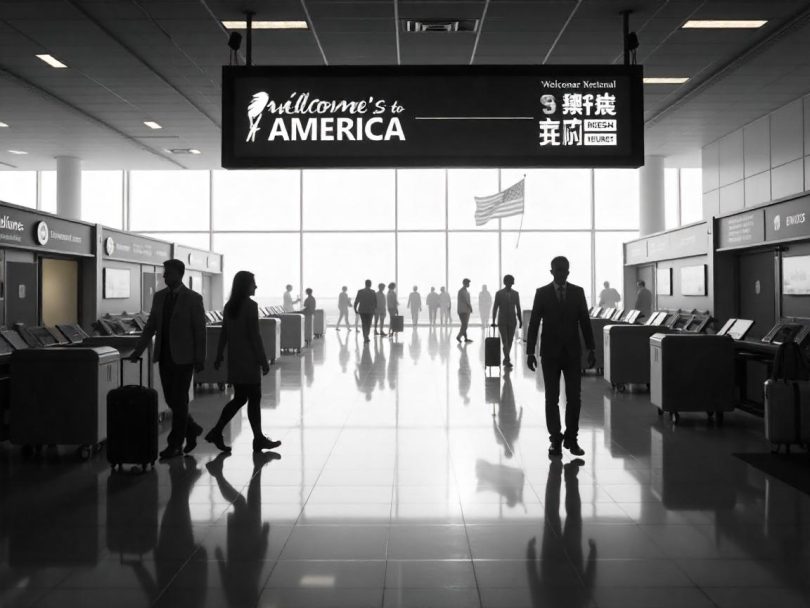Saturday, May 24, 2025
The American tourism crisis is no longer a slow burn—it’s a full-blown emergency. As tourists from Canada, Mexico, the UK, Japan, China, Germany, France, Brazil, and South Korea back away from U.S. travel plans, the alarm bells are ringing louder than ever. A shocking new report reveals that more than Twenty Three Billion USD in GDP and over two Hundred Thousand jobs hang in the balance. And the reasons? They’re more explosive than you think.
Trump tariffs, tight border control, and soaring costs in airlines and hotels are forming a perfect storm. These issues are not just irritating travelers—they’re driving them away entirely. Tourists from Canada, once the U.S.’s most loyal neighbors, are turning their backs. Meanwhile, visitors from Mexico, UK, and Germany are second-guessing their summer vacations. And the silence from Japan, China, France, Brazil, and South Korea? Deafening.
This isn’t a temporary slump. It’s a seismic shift. The American tourism crisis is now a tale of lost dollars, canceled trips, and empty hotel rooms. With international travelers eschewing the U.S. in growing numbers, every canceled booking is another crack in the economic foundation.
Transitioning from boom to bust, America’s once-thriving tourism machine is sputtering. But the full story goes even deeper.
What exactly pushed these countries to turn their backs on the U.S.? How much worse can it get? And what does this mean for the workers, cities, and businesses that once thrived on tourism?
Read on. The truth is more urgent—and unsettling—than you think.
The U.S. travel and tourism industry is facing its steepest challenge in years. International travel to the United States is plunging, and the ripple effects are already rattling the backbone of the nation’s service economy.
Airline bookings are down. Visa cancellations are rising. Stricter border controls are discouraging visitors. Foreigners are pressing pause on their U.S. travel plans—and the financial fallout is becoming hard to ignore.
A projected 10% drop in international tourism this year could slash $23 billion from America’s gross domestic product. That means the loss of nearly 230,000 jobs, mostly across restaurants, hotels, entertainment venues, and retail sectors. The economic shock is real. And it’s unfolding fast.
Restaurants, Hotels, and Retail Are Bleeding Jobs
The impact is hitting hardest where it hurts most—in service-oriented sectors. These industries rely heavily on foot traffic from global tourists.
Dining services are expected to lose more than 50,000 jobs. Hotels and lodging aren’t far behind, shedding nearly 45,000 positions. Entertainment venues may drop another 25,000, while retail—including gas stations—is bracing for around 19,500 job cuts.
These aren’t just numbers. They represent real families, livelihoods, and communities being shaken by a sharp decline in foreign spending.
Even worse, service sectors lack the automation buffer other industries enjoy. That makes employment in these sectors highly vulnerable to sudden drops in consumer demand.
Lost Income, Lost Momentum
As jobs disappear, so do paychecks. Experts estimate over $13 billion in lost labor income this year alone—covering wages, salaries, and independent earnings.
That money would have been spent on groceries, rent, and car payments. Now, it vanishes into thin air. The decline in tourism doesn’t just hurt workers; it weakens consumer spending and deepens economic drag across the board.
For every dollar lost from a foreign tourist, the broader U.S. economy loses an additional $1.19. That’s how deeply intertwined travel spending is with America’s financial health.
Canada Leads the Boycott as Border Towns Suffer
Nowhere is the fallout more dramatic than along the U.S.-Canada border. Canadian travelers—once a consistent flow into American border towns—are staying home in droves.
From Washington State to New York, small towns are watching their local economies grind to a halt. Shops are empty. Hotels are vacant. Gas stations are quiet.
Tensions between U.S. trade policy and Canadian public sentiment have reached a boiling point. Many Canadians are deliberately boycotting American destinations in protest of trade hostility and perceived political insults. Their message is clear: enough is enough.
In April alone, the number of Canadian visitors to the U.S. by land dropped 35%, and air travel fell 20%. The full-year forecast predicts a 20% plunge in Canadian tourism to the U.S.—a devastating blow to businesses that depend on this traffic.
From Europe to Japan, Tourists Turn Away
It’s not just Canada. Europe is cooling toward American vacations as well. Western Europe is expected to send 6% fewer visitors to the U.S. this year.
Currency fluctuations add fuel to the fire. The U.S. dollar remains strong compared to many global currencies, making American vacations more expensive. Tourists from Japan and Brazil, for example, are seeing their purchasing power shrink by nearly 30% compared to 2019.
That means fewer bookings, shorter stays, and tighter budgets for those who do visit. The high cost of American travel is driving global tourists toward more affordable destinations in Europe, Asia, and Latin America.
Missed Momentum: From Optimism to Decline in Just Months
Just months ago, industry insiders were brimming with optimism. In December 2024, projections called for an 8.8% rise in international arrivals and a 16% boost in foreign tourism spending in 2025.
That optimism has collapsed.
Now, recent figures show an 11% drop in flights booked to the U.S. for peak summer months. April offered a brief reprieve, as late Easter bookings inflated arrival numbers—but that couldn’t fully offset March’s sharp dip. Over the two-month span, international arrivals still declined 1.6%.
Tourism experts believe some travelers are simply delaying their trips. But many are quietly choosing other destinations altogether—or canceling plans indefinitely.
What’s Behind the Decline?
A toxic mix of economic and political factors is turning away travelers:
- Tariff tensions and trade wars are souring international goodwill.
- Canceled visas and increased scrutiny at customs checkpoints are making the U.S. less welcoming.
- High travel costs, including airfare, lodging, and currency conversion, are pushing people to look elsewhere.
Each of these elements is deterring visitors—and together, they form a perfect storm.
The Domino Effect: From Tourism to Broader Economic Pain
When tourists vanish, the pain spreads beyond just travel and hospitality. It hits local suppliers, small businesses, and regional economies.
From Miami to Manhattan, from Las Vegas to Los Angeles, popular tourist cities are at risk of losing millions in revenue. Even if mass layoffs are avoided, many workers will likely see reduced hours—and thinner paychecks.
That means less spending at local stores, more loan defaults, and growing financial stress for families living paycheck to paycheck.
A Call to Action for U.S. Travel Stakeholders
This isn’t just a blip on the radar. It’s a flashing red warning light.
America must act swiftly to reverse course. That means easing visa processing, reducing border friction, and rebuilding international goodwill through diplomacy.
Meanwhile, businesses must rethink marketing strategies, offering discounts and incentives to lure back foreign travelers. The government should also consider financial relief for regions hardest hit by the tourism downturn.
The United States has long been one of the world’s most popular destinations, drawing millions of travelers every year to its vast national parks, iconic cities, world-class shopping, and vibrant culture. But have you ever wondered where all these international visitors are actually coming from?
While it’s easy to assume global tourism is evenly distributed, the truth is far more nuanced—and incredibly important. Understanding the pipeline of inbound tourism reveals both the strength and the vulnerabilities of America’s travel economy, especially now, as geopolitical tension and economic headwinds shift global travel behavior.
Let’s explore the countries most responsible for filling U.S. hotels, restaurants, and attractions—and how those flows are evolving in 2025.
Canada: The Neighbor That Keeps Giving (or Not)
No country sends more travelers to the United States than Canada. Thanks to a shared border, common language, and tight family and business ties, millions of Canadians cross into the U.S. each year—by air, by car, and even by foot.
Historically, Canadians flock to Florida in the winter, shop in New York, and explore the Pacific Northwest. But recent political tensions, stricter border checks, and rising costs have led to a significant pullback. Canadian land crossings fell by 35% this year, while air arrivals dropped 20%.
This decline isn’t just a travel statistic—it’s a crisis for border towns in states like Washington, New York, and North Dakota, where local economies depend on a steady stream of Canadian visitors.
Mexico: A Lifeline of Culture and Commerce
Mexico is another top contributor to U.S. tourism, especially in southern states like Texas, California, and Arizona. Family visits, cross-border shopping, and short leisure trips dominate the traffic.
Many Mexican tourists arrive via land border crossings, making them a crucial part of daily commerce in many U.S. communities. But with increased scrutiny at entry points and travel warnings on both sides, the volume has slowed.
Even so, Mexico remains a vital link in America’s travel chain—economically, culturally, and geographically.
United Kingdom: The Atlantic Connection
Crossing the pond, the United Kingdom continues to be a major engine of U.S. tourism. British visitors are drawn to iconic destinations like New York City, Orlando’s theme parks, and the West Coast’s sprawling landscapes.
They spend big and stay longer than many others. But post-pandemic travel hesitation and economic uncertainty in Europe have led to more cautious planning. Still, the U.K. remains one of the most resilient sources of tourism revenue, and British travelers continue to rank among the most dependable.
Japan: Precision Meets Passion
Japanese tourists have a unique footprint in the U.S. They gravitate toward highly organized, detail-driven trips, often centered around cultural experiences, shopping, and cuisine.
Hawaii and California are favorites, but cities like New York and Chicago also see strong interest. Currency challenges—like a weakened yen—have made U.S. travel more expensive in 2025, slightly slowing the pace. However, Japan’s love affair with American culture and destinations remains strong.
China: Big Spenders on Pause
Before the pandemic, China was the rising star of U.S. tourism. Chinese travelers typically spent more per trip than any other nationality, often coming for luxury shopping, university visits, and cross-country tours.
But political tensions, visa issues, and economic strain back home have dramatically reduced Chinese tourism to the U.S. While the potential remains enormous, 2025 continues to see a stall in recovery from this once-booming source.
Germany and France: Europe’s Steady Stream
Germany and France deliver a consistent stream of cultural travelers. Germans love road trips and national parks, while French visitors often zero in on American art, fashion, and city life.
These tourists are particularly drawn to the East Coast and American South. Economic conditions in Europe have led to a slight dip in outbound travel, but these two countries remain vital contributors to America’s tourism lifeline.
Brazil: High-Spending Trendsetters
Though farther away, Brazil is a heavyweight when it comes to spending. Brazilian tourists are known for their enthusiasm for U.S. shopping, theme parks, and major urban centers.
However, the strong dollar has made U.S. trips more expensive for Brazilians in 2025, reducing their volume somewhat. Still, their impact on retail and luxury sectors is substantial—making them highly sought-after visitors.
South Korea and India: Emerging Powerhouses
Both South Korea and India are showing strong momentum in 2025.
South Korean travelers, often tech-savvy and urban-focused, love cities like San Francisco and Seattle. Meanwhile, India’s growing middle class and robust diaspora connections make it one of the fastest-growing inbound markets.
Education, business, and long-haul vacations are pushing Indian arrivals steadily upward—despite visa delays and flight costs.
The Bigger Picture: Shifting Sands in Global Travel
In 2025, travel trends are changing. Economic challenges, currency imbalances, and heightened border control are reshaping how, why, and when people travel to the U.S.
Yet even with these shifts, the appeal of America’s destinations—from Yellowstone to Times Square—remains global and enduring.
The key now is adaptability. Tourism authorities must respond with smarter marketing, friendlier visa policies, and more competitive pricing to retain their international audience. Because while travelers may change their plans today, the right strategy can win them back tomorrow.
America’s Global Travel Web Is Fragile but Fixable
International travelers don’t just fill hotel rooms—they fuel an economic machine that touches every corner of American life. From a barista in Boston to a bellhop in Vegas, their absence is deeply felt.
Knowing where they come from helps us understand where to go next.
The Time to Adapt Is Now
Tourism has long been a quiet powerhouse in the U.S. economy—fueling millions of jobs and billions in revenue. But right now, it’s under siege.
Global travelers are turning away. Local businesses are feeling the strain. And without rapid intervention, the damage could stretch far beyond 2025.
The travel industry must wake up, recalibrate, and fight to reclaim its global allure. The clock is ticking—and the cost of inaction is rising fast.
Source: Fortune











